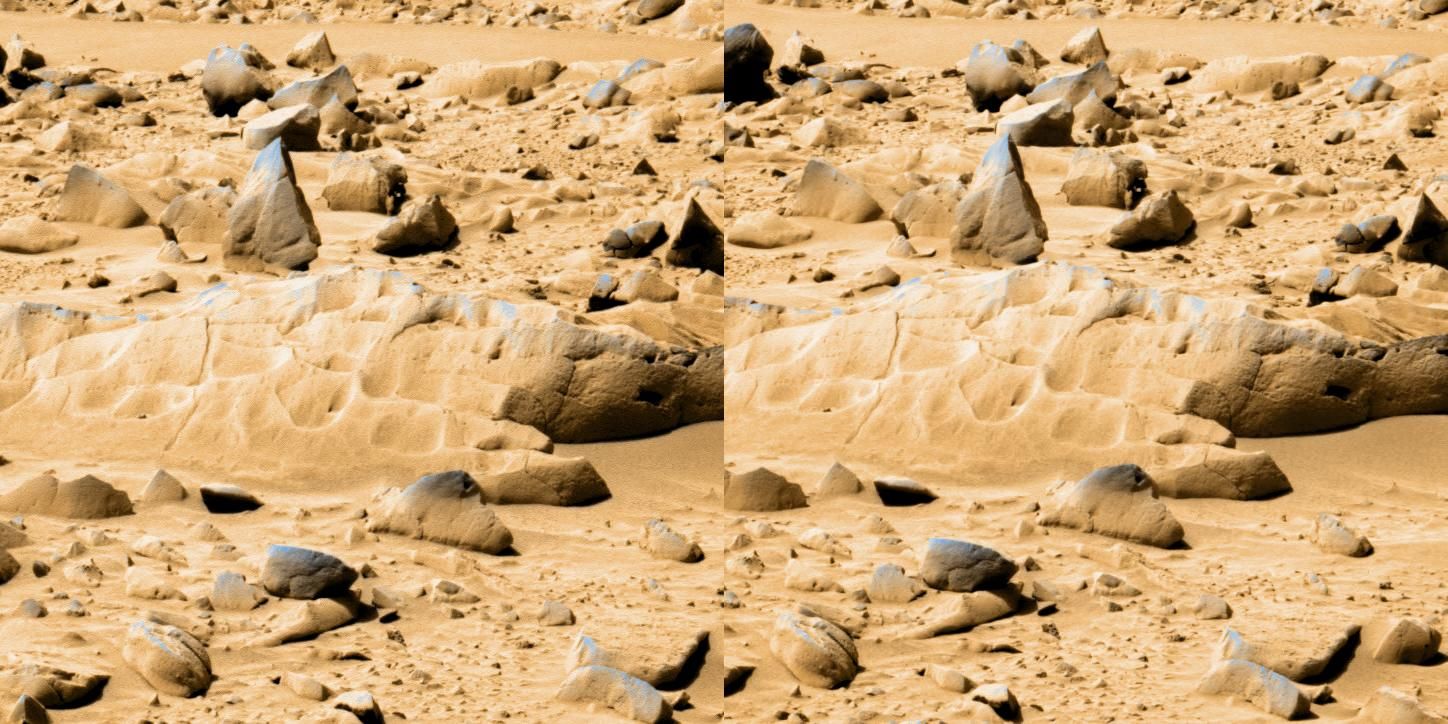
A previous report on the Spirit rover Sol 076 image describes what were seen as a number of anomalies. However, for most people who responded to the report, all the objects in the image looked like rocks. This article attempts to clarify which object attributes are thought to be not consistent with rocks. The object features are interpreted as little as possible, and then only to point out how un-rock-like the objects are. Monocular views of individual objects were cropped from the original image, magnified, edge-enhanced if that was helpful, and labeled to identify the features in question. For those with access to a stereo viewer, magnified stereo images of the objects can be found in the previous report.
Figure 1 is the stereo version of the complete image found in the Northwestern University stereo image archive with an Image ID number of 426. Click on the image to see a larger version.
 |
The object properties in this image thought to be inconsistent with rocks can be called thin material, fabric material, cylindrical shape, feathered edge, and hollowness.
Two objects in the image appear to be thinner than one would expect a rock to be. The edges of the thin sheets of material are marked with rectangles in Figure 2. The first sample shows that the thin, curved material partially encloses a space, and the view through a stereo viewer reinforces that idea. Although the curved edge appears as if it could be part of the rock in the background, the stereo view makes clear that it is not. The thin edge stands by itself. The thin sheet in the second row of Figure 2 is also curved but does not enclose a space.
Note that the texture in these images seems to have been enhanced by the interpolation algorithm used for magnification. This texture should not be confused with the fabric material feature discussed below.
| Magnified | Labeled |
|---|---|
 |
|
 |
The approximately cylindrical object in Figure 3 is topped at the right end with another sample of thin curved material that is not like a rock. It might be better interpreted as a piece of fabric which has become partially unwrapped from around the object and rolled back. The proposed unwrapped part is roughly outlined in blue. Also of interest is the precise square hole located at the bright spot in the yellow rectangle. This hole would be in the fabric if it continued around the back of the cylinder. Further, as seen through the stereo viewer, the dimmer spot inside the yellow rectangle is positioned slightly closer to the camera. It appears to be a reflection from a small area near the axis of the cylinder. The spot is further evidence that the object is not a rock since rock material is unlikely to reflect light noticeably.
| Magnified | Labeled |
|---|---|
 |
The object outlined with a rectangle in Figure 4 has fuzzy, feathered edges that would not be associated with a rock. The feathered nature of the edges can be seen even more readily in the stereo view.
| Magnified | Labeled |
|---|---|
 |
 |
The sample in Figure 5 is partly a cylindrical object that appears to reduce to a smaller diameter inside the cylinder. If this is a rock, it would be highly unusual.
| Magnified | Enhanced and labeled |
|---|---|
 |
 |
Besides the first object in Figure 2, there are additional objects in the original image that appear to be hollow, especially in the stereo view. Hollow rocks on earth such as geodes need lots of moisture to form, and this seems in short supply on Mars. Further, there is no evidence of the crystalline buildup typical of geodes inside the cavities. So hollowness of some objects should also be considered an anomaly. Since most of the apparently hollow objects also appear to have thin walls, the hollowness feature may be related to the thin material feature. Figure 6 shows some samples of hollow objects found in the image.
Sample(Row 1, Col 1) is the same object shown in Figure 1. It was noted that the object appears hollow due to the presence of the thin shell of material curving around the back of the object.
Sample(1,2) shows an object which seems to be hollow and has several holes in its side.
Sample(1,3) shows an object that appears to have a hollow interior seen through the open right side.
Sample(2,1) shows an object with an opening at its lower left. Through the stereo viewer, faint texture can be seen inside the dark area, and it appears to be inside the object.
Sample(2,2) shows an object from the upper right of the original image. The end of the object appears to have broken off, exposing a darkened area just above the broken end piece. This darkened area is unlikely to be a shadow given the direction of the light in the image. The alternative is that the object is hollow, and the dark area is actually an opening to its interior.
| Col 1 | Col 2 | Col 3 | |
|---|---|---|---|
Row 1 |
|||
Row 2 |
The objects discussed above are the best evidence at the perceptual level that the image contains objects that are not mere rocks. The conclusion is based on the apparent physical properties of the objects such as texture and shape. At this level of analysis, the most accurate impressions are gained by using a stereo image viewer. Since these objects do not seem to fit easily into the category of rocks, another explanation for their existence may be needed.